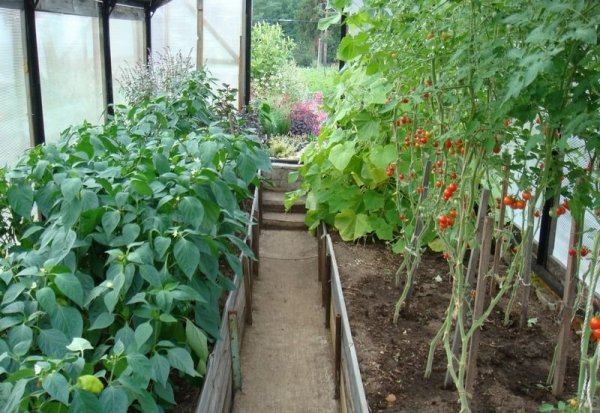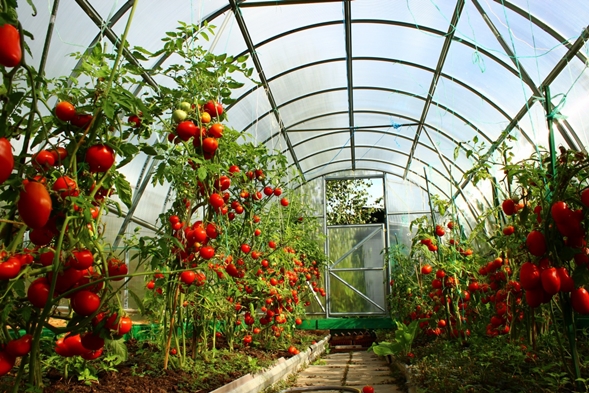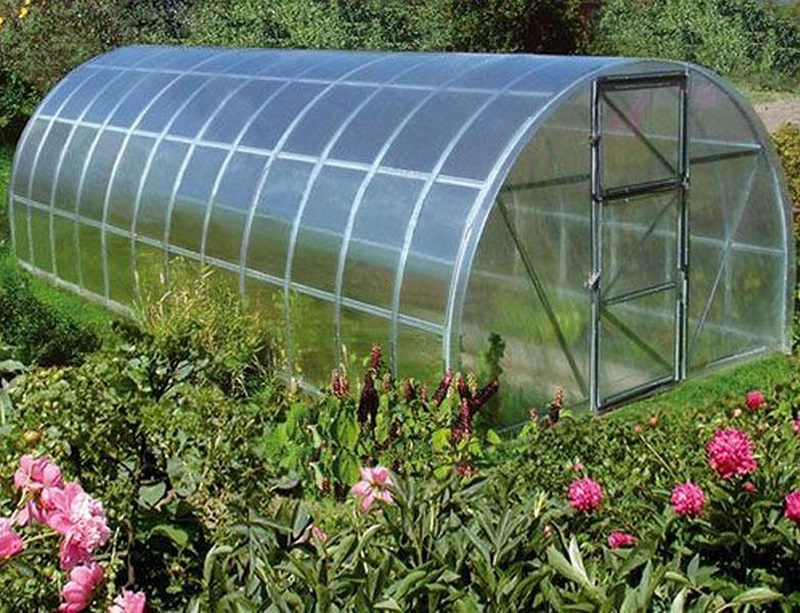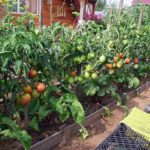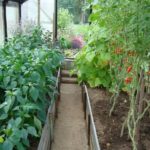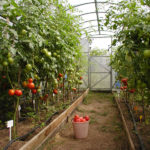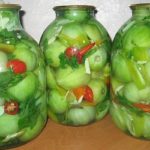Amateur gardeners often wonder: what can be planted with tomatoes in a greenhouse? Not all gardeners and summer residents have the opportunity to grow greenhouse cucumbers and tomatoes.
Those who have installed a greenhouse on their site need to decide how to wisely use every centimeter of usable space in order to get the maximum benefit. When planting vegetable crops, you should consider their compatibility with each other and what can be planted together.
Characteristics of culture
Tomatoes belong to the nightshade family.They were brought from the country of South America. They are found there as a wild plant. In our country, tomatoes are classified as the main crops. Water them rarely, but with plenty of water.
Humidity is harmful to them. They are susceptible to various fungal diseases. Light is as important for them as a sufficient amount of fresh air. When there is insufficient lighting, the plants become very elongated, the leaves dry out and become lighter in color. Let's look at what can be planted with tomatoes.
What can be planted with tomatoes in spring and summer
Under certain conditions, tomatoes can coexist with cucumbers, sweet peppers and eggplants in the same greenhouse. Plants compatible with tomatoes are: radishes, garlic and onions.
Only those onions and tomatoes are planted that will later be used as green ones. Garlic, with its phytoncidal properties, helps tomatoes in the fight against late blight, to which they are more susceptible than other nightshades. Some gardeners collect garlic shoots, infuse them with alcohol and spray the tomatoes.
Strawberries and wild strawberries take root well next to tomatoes. These plants, like tomatoes, love a lot of air and light, are not afraid of drafts, on the contrary, ventilation benefits them, and the process of natural pollination of both occurs. When planting together, strawberries and tomatoes are planted in a ratio of 60x45.
Melissa, celery, parsley, and basil can also be considered excellent neighbors for tomatoes. When growing lemon balm and basil next to tomatoes, a significant improvement in the taste of tomatoes was noticed.
Any neighborhood of the listed vegetables will be useful if the tomato bushes are tied up so as not to interfere with the penetration of light.
Usually, when planting main crops, the row spacing and edges of the beds are left unoccupied.In this case, it is advisable to plant mustard, lettuce, rhubarb and radishes in the greenhouse along with tomatoes. Moreover, they can be planted when the tomatoes have just emerged from the ground, and harvested when the tomatoes have grown so much that they occupy the entire area in the garden bed. And then only the main crops remain on the beds, for which planting in the greenhouse was planned.
What do they plant in the cold?
The greenhouse can be used not only in spring and summer, but also during frosts. To do this, the greenhouse must be properly insulated. And then, together with tomatoes, it is permissible to grow watermelons, strawberries, and also plant strawberries and melons. Not every gardener can share their experience of growing watermelon in a greenhouse. The fact is that melons require a special approach. Tomatoes cannot grow without adequate ventilation in the greenhouse.
Watermelon and melon, on the contrary, do not like drafts. This is the main reason why melons are grown separately from other vegetables. In general, experienced gardeners do not allow the greenhouse to stand idle for a long time out of season.
What can you grow in a greenhouse at this time of year? According to the recommendations of many amateur gardeners, you can plant vegetable seedlings in a greenhouse. With the onset of spring it can be transferred to the ground. This procedure will have a beneficial effect on the yield of main crops.
As soon as weather conditions become favorable, the seedlings can be sent to the beds, and space in the greenhouse is freed up for the main garden crops. The soil has already been prepared and cultivated, which helpsThis encourages rapid plant growth and subsequently a good harvest is expected.
What can you plant with tomatoes in the fall?
In the autumn, greenery is planted, and thus the greenhouse is not idle and is used all year round.So, which neighbors are favorable for tomatoes? Asparagus beans are planted together with tomatoes. In a greenhouse it can produce a much larger yield than in soil outdoors. By combining the planting of these two crops, you can get a much larger harvest of tomatoes.
Moreover, beans and tomatoes help each other if planting is done by alternating in the beds. Beetroot feels great in a greenhouse with tomatoes. This proximity is good for them.
Beets do not interfere with tomatoes, but tomatoes can slightly darken the places where beets are planted, and therefore it is necessary to collect them earlier.
Recently, mixed plantings have become very popular: tomatoes, spinach, strawberries, watercress, savory and parsley. It is important to properly prepare the heifer. It is filled with organic soil in the fall, then in the spring it is additionally fertilized with manure and finally, fertile soil is brought in. This composition is ideal for growing vegetables and herbs.
With this approach, it is important to determine which beds will contain the main crops, and leave them empty or fill them with fast-growing plants, such as Chinese cabbage seedlings or leaf turnips. You can use means to accelerate growth, then they will have time to ripen before planting tomatoes.
When planting seeds of lettuce, Chinese cabbage and spinach in March, use small containers in which sawdust is pre-soaked. At the same time, the seeds are not sown densely, because the growing plants will remain in containers for more than a month. Containers are placed in bags; they must be open to allow oxygen access.
After the seeds have sprouted, they are sprinkled with a small layer of soil.The seedlings are taken out of the bags and placed in an open place, perhaps on a windowsill. As soon as weather conditions allow, you can plant plants in the greenhouse.
Before planting, seedlings are watered abundantly, which helps to carefully separate the bushes without damaging the roots. It is important not to keep the seedlings in sawdust. A long stay in this soil deprives the plant of nitrogen. Before planting in the soil, garlic and bulbs should be filled with a small amount of water in small containers. In the greenhouse they should be located on one small bed close to each other. When the time comes to plant tomatoes, the greens should already be harvested.
Which plants are best not to plant with?
Tomatoes do not do well with other crops. Many gardeners never plant them with cucumbers. The proximity can have a detrimental effect on the yield of both crops. They need to create different microclimates. Tomatoes need dry air with frequent ventilation; they need to be watered rarely, but abundantly.
Cucumbers, on the other hand, love moisture and frequent, but not abundant watering. They can be planted in the same greenhouse, but in different places. When placed near tomatoes, cucumbers begin to ache, wither and rot.
The same thing happens when the greenhouse is frequently ventilated. In addition, the curly tendrils of cucumbers can entwine the stems of tomatoes, thereby interfering with their growth. Tomatoes can become covered with fungus due to frequent watering and high air humidity.
Greenhouse fennel and peas interfere with the growth of tomatoes. But at the same time, peas are compatible with cucumbers. You cannot grow tomatoes and potatoes together in a greenhouse. Compatibility can only occur if the potatoes are grown from seeds. Tomatoes and cabbage do not get along well together. Especially such varieties as kohlrabi and cauliflower.
Plant placement methods
If necessary, you can plant tomatoes along with other crops. Whether or not to plant incompatible vegetables in a greenhouse is everyone’s business, but there is a way out. Experienced gardeners suggest rationally using the entire area of the greenhouse and using the correct planting organization. With a rational approach, you can not only not harm the growth of the crop, but also increase it by 30%.
There are several ways to accommodate incompatible plants in a greenhouse. The design of the greenhouse itself plays an important role here. If it has two entrances and there is enough space for planting vegetables, then 3 beds are dug up first. Tomatoes are planted in the central bed, since this part is the most ventilated.
Cucumbers are located in the southern part of the greenhouse, and eggplants are located on the northern side. Even with this approach, experts do not recommend planting cucumbers together with tomatoes. This is due to the fact that the care when growing them is completely different.
If the greenhouse has one door and a window, then the layout of the planting material is as follows: tomatoes are placed opposite the door, and they are separated from other plants using film. You can also use sheets of plywood or slate.
Most gardeners who use this method of planting prefer film. Cucumbers are planted behind the tomatoes, followed by eggplants. That is, the most heat-loving and draft-resistant vegetables are located in the center. It is preferable to plant peppers under the window. This culture loves cool weather.
You can plant all these crops together in a greenhouse if there is a need for this, but in this case you need to be prepared for the fact that the yield will drop slightly, but still.Considering that the problem of compatibility of various vegetable crops is known to many gardening enthusiasts, greenhouse manufacturers began to produce structures with various internal modifications.
When installing them on the site, internal partitions and ceilings are installed. With their help, you can design separate “rooms” for planting plants at your discretion. At the same time, each individual room will have its own microclimate, which will give many gardeners the opportunity to grow different vegetable crops at the same time, combine incompatible things and get a full harvest. And then there will be no dilemma about what to plant with tomatoes.

